
It is true, it is not easy to pass the Microsoft AZ-120 exam. Almost no one passed it the first time! This makes me wonder, how difficult is the AZ-120? Feel the material provided on the Internet is a bit too messy? How can it be easy to pass? Purchase AZ-120 exam dumps on Pass4itSure (link https://www.pass4itsure.com/az-120.html), AZ-120 dumps have been recognized by many IT workers, because of the resources of AZ-120 have It is reliable and timely.
Not difficult to pass, AZ-120 exam dumps PDF download
AZ-120 exam PDF free share https://drive.google.com/file/d/1pfi_m-zyhfosKsRuLHZWkCgDO60BitUs/view?usp=sharing Contains some AZ-120 exam questions and answers, and the PDF format is convenient for you to study at any time! More on Pass4itSure AZ-120 dumps.
Come and learn, Microsoft AZ-120 practice test free – AZ-120 dumps
QUESTION 1 #
You deploy an SAP environment on Azure by following the SAP workload on the Azure planning and deployment checklist.
You need to verify whether Azure Diagnostics is enabled.
Which cmdlet should you run?
A. Get-AzureVMAvailableExtension
B. Get-AzVmDiagnosticsExtension
C. Test-AzDeployment
D. Test-VMConfigForSAP
Correct Answer: B
The Get-AzVMDiagnosticsExtension cmdlet gets the settings of the Azure Diagnostics extension on a virtual machine.
Incorrect Answers:
D: You can check the configuration of a virtual machine by calling the Test-VMConfigForSAP_GUI commandlet.
References: https://docs.microsoft.com/en-us/powershell/module/az.compute/get-azvmdiagnosticsextension
QUESTION 2 #
You plan to deploy SAP application servers that run Windows Server 2016.
You need to use PowerShell Desired State Configuration (DSC) to configure the SAP application server once the
servers are deployed.
Which Azure virtual machine extension should you install on the servers?
A. the Azure DSC VM Extension
B. the Azure virtual machine extension
C. the Azure Chef extension
D. the Azure Enhanced Monitoring Extension for SAP
Correct Answer: A
The Azure Desired State Configuration (DSC) VM Extension is updated as needed to support enhancements and new
capabilities delivered by Azure, Windows Server, and the Windows Management Framework (WMF) that includes
Windows PowerShell.
References: https://docs.microsoft.com/en-us/powershell/scripting/dsc/getting-started/azuredscexthistory
QUESTION 3 #
You deploy an SAP environment on Azure.
Your company has a Service Level Agreement (SLA) of 99.99% for SAP.
You implement Azure Availability Zones that have the following components:
1.
Redundant SAP application servers
2.
ASCS/ERS instances that use a failover cluster
3.
Database high availability that has a primary instance and a secondary instance You need to validate the high
availability configuration of the ASCS/ERS cluster. What should you use?
A. SAP Web Dispatcher
B. Azure Traffic Manager
C. SAPControl
D. SAP Solution Manager
Correct Answer: B
Incorrect Answers:
C: You can use SAPControl to start or stop an SAP system from the command line.
References: https://docs.microsoft.com/en-us/azure/architecture/reference-architectures/sap/sap-netweaver
QUESTION 4 #
HOTSPOT
For each of the following statements, select Yes if the statement is true. Otherwise, select No.
NOTE: Each correct selection is worth one point.
Hot Area:
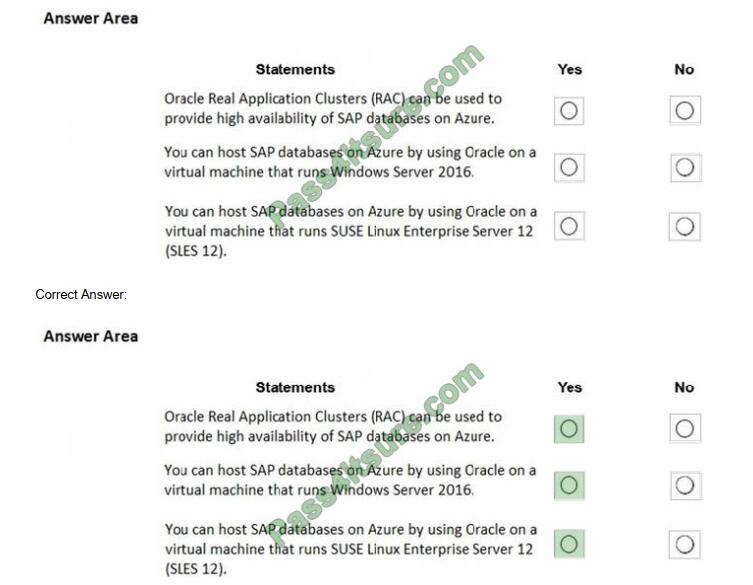
Box 1: Yes
Box 2: Yes
Oracle Database 12c Release 2 (12.2) is certified on Microsoft Windows Server 2016 (Standard, Datacenter, and
Essentials Editions), which includes support for the database client, server, and Oracle Real Application Clusters.
Organizations can run SAP applications with Oracle databases on the same code base on Unix, Linux, and Windows
operating systems.
Box 3: Yes
References:
https://docs.microsoft.com/en-us/azure/virtual-machines/workloads/oracle/oracle-overview
https://docs.oracle.com/en/database/oracle/oracle-database/12.2/ntdbn/index.html#
QUESTION 5 #
DRAG-DROP
You are validating an SAP HANA on Azure (Large Instances) deployment.
You need to ensure that sapconf is installed and the kernel parameters are set appropriately for the active profile.
How should you complete the commands? To answer, drag the appropriate values to the correct targets.
Each value may be used once, more than once, or not at all. You may need to drag the split bar between panes or scroll to view content.
NOTE: Each correct selection is worth one point.
Select and Place:
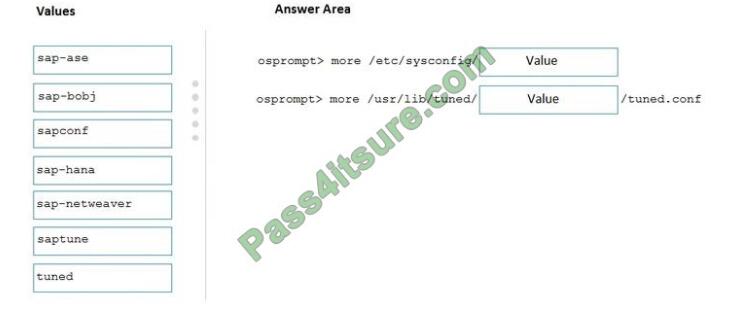
Correct Answer:
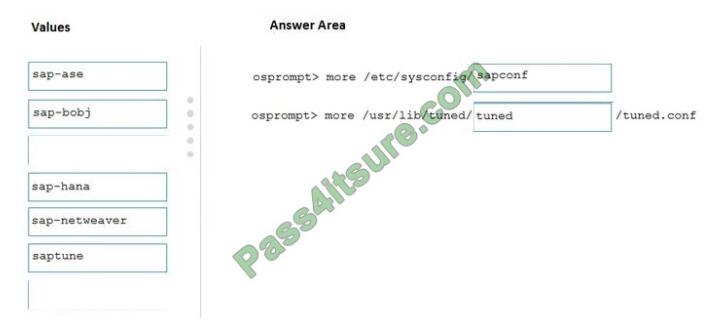
Box 1: sapconf The configuration is split into two parts: /etc/sysconfig/sapconf /usr/lib/tuned//tuned.conf
Box 2: tuned
References: https://www.suse.com/c/sapconf-a-way-to-prepare-a-sles-system-for-sap-workload-part-2/
QUESTION 6 #
Ask: You plan to deploy an SAP environment on Azure that will use Azure Availability Zones. Which load balancing solution
supports the deployment?
A. Azure Basic Load Balancer
B. Azure Standard Load Balancer
C. Azure Application Gateway v1 SKU
Correct Answer: B
When you deploy Azure VMs across Availability Zones and establish failover solutions within the same Azure region,
some restrictions apply:
You can\\’t use an Azure Basic Load Balancer to create failover cluster solutions based on Windows Server Failover
Clustering or Linux Pacemaker. Instead, you need to use the Azure Standard Load Balancer SKU.
References:
https://docs.microsoft.com/en-us/azure/virtual-machines/workloads/sap/sap-ha-availability-zones
QUESTION 7 #
QA: You plan to migrate an on-premises SAP development system to Azure.
Before the migration, you need to check the usage of the source system hardware, such as CPU, memory, network,
etc.
Which transaction should you run from SAP GUI?
A. SM51
B. DB01
C. DB12
D. OS07N
Correct Answer: D
SAP transaction OS07N (Remote Operating System Activity) is classified in the Basis Component module under
application component Operating System Monitors and runs Monitoring Operating System program RSHOST1N upon
execution.
Incorrect Answers:
A: Transaction code SM51 is to display a list of active application servers that have registered in the SAP message
server.
B: DB01 is a transaction code used for Analyze Exclusive Lockwaits in SAP.
C: Transaction code DB12 is to collects and presents information that is necessary to monitor database backups.
References: http://www.saptransactions.com/codes/OS07N/
QUESTION 8 #
Note: This question is part of a series of questions that present the same scenario. Each question in the series contains
a unique solution that might meet the stated goals. Some question sets might have more than one correct solution,
while others might not have a correct solution.
After you answer a question in this section, you will NOT be able to return to it. As a result, these questions will not
appear in the review screen.
You deploy SAP HANA on Azure (Large Instances).
You need to back up the SAP HANA database to Azure.
Solution: You use a third-party tool that uses backing to back up the SAP HANA database to Azure storage.
Does this meet the goal?
A. Yes
B. No
Correct Answer: B
References: https://docs.microsoft.com/en-us/azure/backup/sap-hana-db-about
https://docs.microsoft.com/en-us/azure/backup/backup-azure-sap-hana-database#configure-backup
QUESTION 9 #
You have an SAP environment on Azure that uses multiple subscriptions.
To meet GDPR requirements, you need to ensure that virtual machines are deployed only to West Europe and
North Europe Azure regions.
Which Azure components should you use?
A. Azure resource locks and the Compliance admin center
B. Azure resource groups and role-based access control (RBAC)
C. Azure management groups and Azure Policy
D. Azure Security Center and Azure Active Directory (Azure AD) groups
Correct Answer: C
Azure Policy enables you to set policies to conform to the GDPR. Azure Policy is generally available today at no
additional cost to Azure customers. You can use Azure Policy to define and enforce policies that help your cloud
environment become compliant with internal policies as well as external regulations.
Azure Policy is deeply integrated into Azure Resource Manager and applies across all resources in Azure. Individual
policies can be grouped into initiatives to quickly implement multiple rules. You can also use Azure Policy in a wide
range of compliance scenarios, such as ensuring that your data is encrypted or remains in a specific region as part of
GDPR compliance.
Microsoft is the only hyper-scale cloud provider to offer this level of policy integration built in to the
a platform for no additional charge.
References: https://azure.microsoft.com/de-de/blog/new-capabilities-to-enable-robust-gdpr-compliance/
QUESTION 10 #
You have an SAP environment that is managed by using VMware vCenter.
You plan to migrate the SAP environment to Azure.
You need to gather information to identify which compute resources are required in Azure.
What should you use to gather the information?
A. Azure Migrate and SAP EarlyWatch Alert reports
B. Azure Site Recovery and SAP Quick Sizer
C. SAP Quick Sizer and SAP HANA system replication
D. Azure Site Recovery Deployment Planner and SAP HANA Cockpit
Correct Answer: A
Azure Migrate is a Microsoft service that helps an enterprise assess how its on-premises workloads will perform, and
how much they will cost to host, in the Azure public cloud. An enterprise can use Azure Migrate to discover information
about the VMware VMs running within its own data center, including CPU and memory usage, as well as performance
history.
SAP EarlyWatch Alert (EWA) is a monitoring service for SAP customers, to monitor SAP systems in the solution
landscape.
Incorrect Answers:
D: SAP HANA Cockpit is an administrative tool with a web interface for a correspondingly named database engine, a
part of SAP ERP software. It allows both offline and cloud operations for managing databases,
References: https://searchcloudcomputing.techtarget.com/definition/Azure-Migrate
QUESTION 11 #
HOTSPOT
You plan to deploy a highly available ASCS instance to SUSE Linux Enterprise Server (SLES) virtual machines in
Azure.
You are configuring an internal Azure Standard Load Balancer for the ASCS instance.
How should you configure the internal Standard Load Balancer? To answer, select the appropriate options in the
answer area.
NOTE: Each correct selection is worth one point.
Hot Area
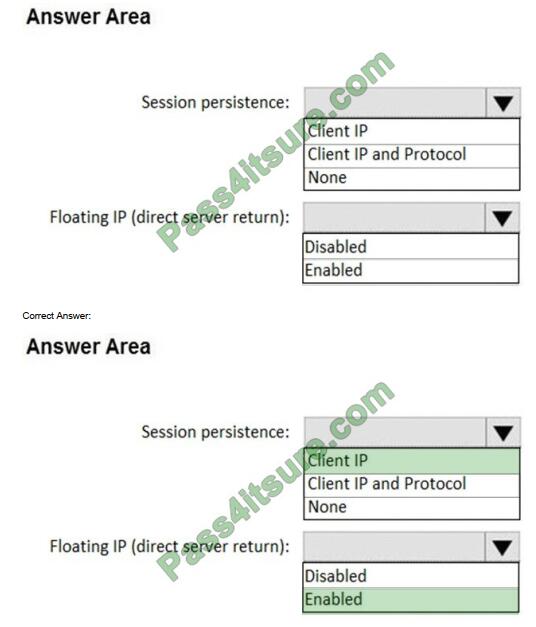
Box 1: Client IP
The standard load balancer allows stateful sessions to remain as there are no IP address changes with this method.
Box 2: Enabled
Make sure to enable Floating IP.
References:
https://docs.microsoft.com/en-us/azure/virtual-machines/workloads/sap/high-availability-guide-suse
QUESTION 12 #
Your on-premises network contains an Active Directory domain.
You have an SAP environment on Azure that runs on SUSE Linux Enterprise Server (SLES) servers.
You configure the SLES servers to use domain controllers as their NTP servers and their DNS servers.
You need to join the SLES servers to the Active Directory domain.
Which three actions should you perform in sequence? To answer, move the appropriate actions from the list of actions
to the answer area and arrange them in the correct order.
Select and Place:
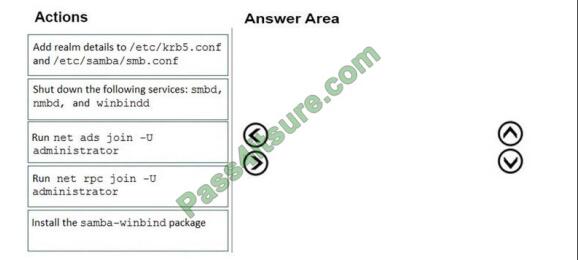
Correct Answer:
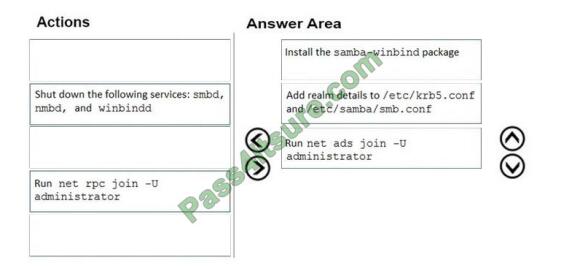
Step 1: Install the samba-winbind package Install samba-winbind
Step 2: Add realm details to /etc/krb5.conf and /etc/samba/smb.conf Edit files – best way to do this is to use yast on test machine and copy files from it In following examples you need to replace EXAMPLE/EXAMPLE.COM/.example.com
with your values/settings /etc/samba/smb.conf [global]
workgroup = EXAMPLE
usershare allow guests = NO #disallow guests from sharing
idmap gid = 10000-20000
idmap uid = 10000-20000
kerberos method = secrets and keytab
realm = EXAMPLE.COM
security = ADS
template homedir = /home/%D/%U
template shell = /bin/bash
winbind offline logon = yes
winbind refresh tickets = yes
/etc/krb5.conf
[libdefaults]
default_realm = EXAMPLE.COM
clockskew = 300 [realms]
EXAMPLE.COM = {
kdc = PDC.EXAMPLE.COM
default_domain = EXAMPLE.COM
admin_server = PDC.EXAMPLE.COM
} ..
Step 3: Run net ads join -U administrator Join the SLES 12 Server to the AD domain
References: https://www.suse.com/support/kb/doc/?id=7018461
QUESTION 13 #
HOTSPOT
For each of the following statements, select Yes if the statement is true. Otherwise, select No.
NOTE: Each correct selection is worth one point.
Hot Area:

Correct Answer:
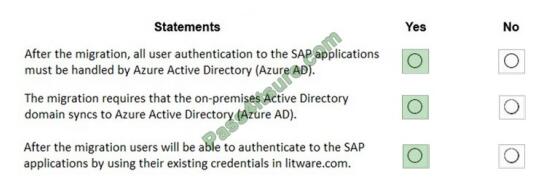
In a Hybrid-IT scenario, Active Directory from on-premises can be extended to serve as the authentication mechanism
through an Azure deployed domain controller (as well as potentially using the integrated DNS).
It is important to distinguish between traditional Active Directory Servers and Microsoft Azure Active Directory that provides only a subset of the traditional on-premises AD offering.
This subset includes Identity and Access Management but does not have the
full AD schema or services that many 3rd party applications take advantage of. While Azure Active Directory IS a
the requirement to establish authentication for the Azure virtual machines in use, and it can synchronize users with
customers.
QUESTION 14 #
HOTSPOT
You have an Azure Availability Set that is configured as shown in the following exhibit.

Use the drop-down menus to select the answer choice that completes each statement based on the information
presented in the graphic.
NOTE: Each correct selection is worth one point.
Hot Area:
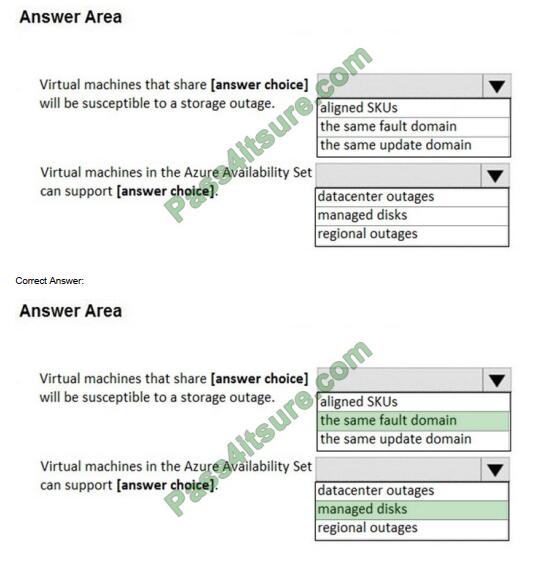
Box 1: the same fault domain
Fault domains define the group of virtual machines that share a common power source and network switch. If a storage fault domain fails due to hardware or software failure, only the VM instance with disks on the storage fault domain fails.
Box 2: managed disks
Managed disks provide better reliability for Availability Sets by ensuring that the disks of VMs in an Availability Set are
sufficiently isolated from each other to avoid single points of failure. It does this by automatically placing the disks in
different storage fault domains (storage clusters) and aligning them with the VM fault domain.
References:
https://docs.microsoft.com/en-us/azure/virtual-machines/windows/manage-availability
QUESTION 15 #
For each of the following statements, select Yes if the statement is true. Otherwise, select No.
NOTE: Each correct selection is worth one point.
Hot Area:
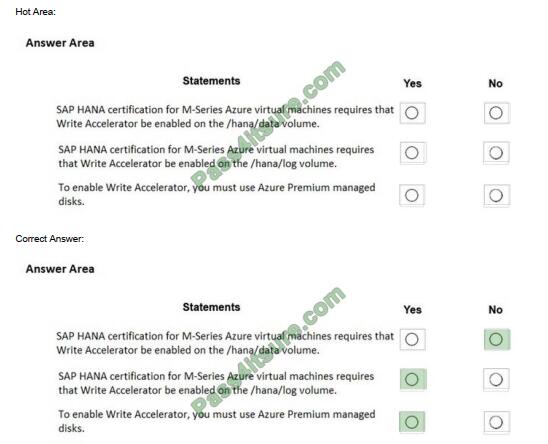
Box 1: No
Box 2: Yes The minimum SAP HANA certified conditions for the different storage types are: Azure Premium SSD – /Hana/log is required to be cached with Azure Write Accelerator. The /Hana/data volume could be placed on Premium
SSD without Azure Write Accelerator or on Ultra disk
Box 3: Yes
References:
https://docs.microsoft.com/en-us/azure/virtual-machines/workloads/sap/hana-vm-operations-storage
Summarize
If you know the right way and know how to deploy the Planning and Administering Microsoft Azure for the SAP Workloads exam, then AZ-120 is not very difficult. Best study resources for AZ-120: Pass4itSure AZ-120 dumps! Pass4itSure has the most complete exam policy! To pass the AZ-120 exam 100%, please click https://www.pass4itsure.com/az-120.html (118 Q&A) Pass4itSure Microsoft exam dumps are trustworthy! I wish you success!

